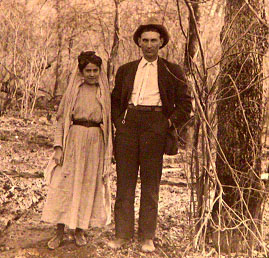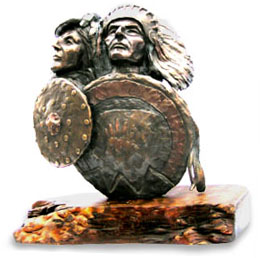Government Mandated Legal Statements Regarding Native American Art...
|
Under the "Indian Arts and Crafts Act of 1990" all American Indian and Alaska Native art and craft products must be marketed truthfully regarding the Native American heritage and tribal affiliation of the artist or craftsperson.
|
|
The following is my family history and tradition, regarding Native American blood lines:
According to my mother, who has been gone from this earth for a number of years, one of her grandmothers (on her mother's side) was a Cherokee full-blood. Keep in mind that mother's are not a source recognized by the US government ! My own father was very much a Scotsman. ! My own father was very much a Scotsman.
My mother’s father, my grandfather, was also of Cherokee blood. His grandparents were from Cherokee, North Carolina. He was born in Boone County, Arkansas in 1887 and passed away in Idaho in 1964. He moved with his wife and daughter from Arkansas for a time (while my mother was a child) and they lived for several years on the Cherokee "reservation" in Oklahoma. My grandfather was a proud man who would never use the word reservation. He always referred to that time as living in the Indian "Nation."

My grandfather and friend, somewhere in Arkansas, circa 1910
In order to be a "registered" member of one of the three federally recognized Cherokee Nations, you have to prove your bloodline with an ancestor who is on one of the following rolls:
1. The Dawes Roll. The Dawes Roll was the "final roll of the five civilized tribes." To appear on that roll, which was taken between 1899 and 1906, an ancestor had to be residing in Indian Territory (now NE Oklahoma) and accept land from the government.
2. The Baker Roll of 1924 for the Eastern Band of Cherokees. A direct lineal ancestor has to be on that roll and you must possess at least 1/16 degree of Eastern Cherokee blood.
3. The Emigration Roll of 1817 and the Old Settler Roll of 1851. For those who emigrated to Arkansas or Oklahoma Territory before the Trail of Tears. The United Keetoowah Band of Cherokee requires an ancestor on one of those rolls, and ¼ degree of “Old Settler” blood.
It has been estimated that the vast majority of the Cherokee people never registered on these roles. A number of those who didn't register had a very justified distrust in getting their names on any government role. Many of those who did register and accept the government handouts were good and honorable people who were forced into doing so by the situations and government mandates of the time. I am proud that some of my ancestors had both the dignity and good sense to avoid the government rolls. I am well aware that many people in our time are now seeking for tribal registration as the brass ring in getting in on the government "dole." I am also aware that there is justification in the art world for preventing non-Indian artists from "cashing in" on a heritage that belongs only to Native American artists. There is understandable "bad feelings" among the latter toward anyone attempting to do so.
| The bottom line is: |
I have no ancestors who subjected themselves to the government rolls, therefore I have no tribal registration, and by federal law have to state that: |
|
None of my art should be viewed as being produced by a "Native American" artist. Anything that I do along those veins should be legally viewed as being only of "Native American style."
|
|
The latter (Native American style) being an "interesting" term in itself. But... that's another story.
Legally having to have said all of that, I still have an understandable fascination for doing a portion of my artwork that is related to Native American culture and subject matter and will continue to do so. I also have the same fascination for doing artwork related to the culture of the Scottish Highlands. My ties to the later are much easier to verify, as I have genealogy records of a direct line of grandparents that include most of the Kings of Scotland.
I have also had a long-standing fascination for the similarity between a number of the Native American cultures and the Scottish Highland culture. Both were a lifestyle where family was revered, the highest glory was individual bravery in battle, and where loyalty to one's tribe or clan was paramount. Such cultures produced some of the fiercest warriors in history. Leading those clans and tribes were the "Chieftains." The bronze by that title (shown below) is the first of a series planed to reflect upon that similarity...

It is fortunate that the government has not been able (thus far) to regulate an artist's choice of subject matter, nor successfully take away (at least on a personal level) their cultural heritage.

 |
 |
Dale in his Idaho Studio...
Working on original wax for future bronze
"The Oldest Jacobite, Patrick Ferguson 1745" |
 |
|